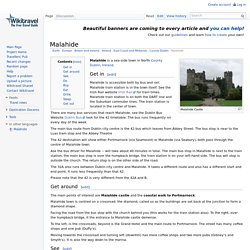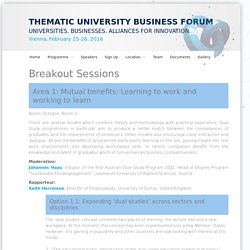

Malahide travel guide. Malahide Castle Malahide is a sea-side town in North County Dublin, Ireland.

Get in[edit] Malahide is accessible both by bus and rail. Malahide train station is in the town itself. See the Irish Rail website Irish Rail for train times. There are many bus services that reach Malahide, see the Dublin Bus Website Dublin Bus look for the 42 timetable. The main bus route from Dublin city centre is the 42 bus which leaves from Abbey Street. The 42 destination will show either Portmarnock (via Seamount) or Malahide (via Seabury), both pass through the centre of Malahide town.
Ask the bus driver for Malahide -- will take about 40 minutes in total. The 32A also runs between Dublin city centre and Malahide. Please note that the 42 is very different from the 42A and B. Get around[edit] Grand Hotel, Malahide, 4 Star Hotel Dublin. DART & Commuter. In Dublin, the electric rail system called the DART (Dublin Area Rapid Transit) is a quick and easy way to get around Dublin.

It runs along the coast of the Irish Sea from Malahide or Howth in north County Dublin soutwards as far as Greystones, Co Wicklow. 102 - Dublin Bus from Dublin Airport to Malahide (about 35 minutes) Taxi from Dublin Airport to Malahide. 1.

Re: Taxi from Dublin Airport There are two kinds of taxis in Ireland - metered and unmetered. All of the taxis you will pick up at airports, railway stations, taxi ranks or hail in the street are metered. Unmetered taxis have to be pre-booked from taxi offices either in person or by phone and they are not allowed to pick up passengers in the streets or at taxi ranks nor tout for business at airports, railway stations etc.
For unmetered taxis, prices are agreed in advance. Nautilus Restaurant Malahide. Gibney's of Malahide. Research Impact workshop. Summary A workshop looking at aspects of measuring research impact and their influence on universities.

About Many governments and research sponsors have expectations that the research they fund will deliver economic, social or cultural impacts. In the past these expectations have been more implicit than explicit. But universities in many countries have staked their claims for increased funding on their pivotal role in delivering economic growth through research and its impact on innovation, and funders are now expecting the sector to demonstrate delivery. The introduction of impact assessment has proved, unsurprisingly, to have been controversial. The view that there should be no expectation that academic research should be required to have impact outside academia. Outline Programme The workshop will be split into three sessions. Pollit. LimeSurvey - the most popular FOSS survey tool on the web. Territorial Innovation Alliances - UK. Professional Meeting Management Software. University Business Forum Austria. Area 1: Mutual benefits: Learning to work and working to learn Room: Octogon, Room 1 There are several models which combine theory and methodology with practical experience.

Dual Study programmes in particular aim to produce a better match between the competences of graduates and the requirements of employers. Other models also encourage close interaction and dialogue. All see the benefits of programme participants learning on the job, gaining insight into real work environments and developing work-based skills. Moderation:Johannes Haas, Initiator of the first Austrian Dual Study Program 2002, Head of Degree Program “Sustainable Foodmanagement”, Joanneum University of Applied Sciences, Austria Rapporteur:Keith Herrmann, Director of Employability, University of Surrey, United Kingdom Option 1.1: Expanding ‘dual studies’ across sectors and disciplines The ‘dual studies’ concept combines two places of learning: the lecture hall and a real workplace. Option 1.2. Thematic University Business Forum. User Experience Research Platform.
A Peek into Usability. SWYP: See What You Print - Artefact. They say simplicity is brilliance…and so we set out to simplify a clunky, complicated, and often-wasteful printing process through design, utility, and efficiency.

The result: SWYP (See What You Print) – a radically simple concept for printing. While many companies believe innovation means adding more features, we believed innovation could come from better core features. As we started to rethink the printer, our guiding design principle to this stagnant and overlooked peripheral was radical simplicity. The concept we landed on was a large, 1:1 scale touch-screen, giving the user the ability to see and manipulate the finished result—before it was printed. Eucen. SHIP Dissemination 2016041101. Évaluation de la formation : de la nécessité d’une stratégie. Défaut de stratégie d’évaluation ?

Une enquête de Féfaur (Pratique de l’évaluation de la formation dans les entreprises françaises, février 2015) le montre sans ambiguïté : 8,7% seulement des entreprises interrogées affirment s'être dotées d’une véritable stratégie d’évaluation de la formation ! Mais il est vrai que la prise de conscience avance à bon pas : 47,8% disent y penser ; 31,8% répondent qu’elles sont en train d’élaborer leur stratégie. Au reste, il faut parler de stratégies, plurielles, d’évaluation, malgré l’existence et la possibilité d’utiliser des approches et des modèles génériques qui ont fait leurs preuves, celui de Kirkpatrick notamment. Car toute stratégie d’évaluation doit prendre en compte les attentes comme les résistances, toujours spécifiques, des salariés, des managers, voire des formateurs et des responsables formation (parfois inquiets d'une possible remise en cause si les résultats ne sont pas à la hauteur).